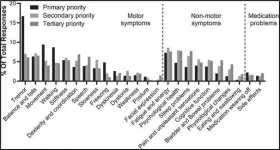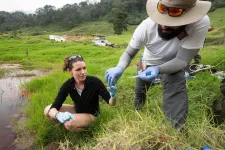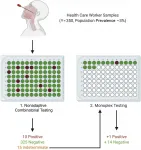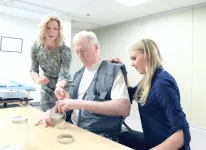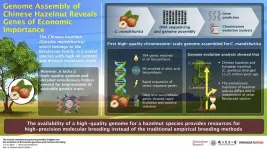Brain changes following traumatic brain injury share similarities with Alzheimer's disease
Using MRIs and machine learning, researchers mapped comparable degenerative changes in gray and white matter of the brain
2021-04-26
(Press-News.org) Brain changes in people with Alzheimer's disease and in those with mild traumatic brain injuries (TBIs) have significant similarities, a new USC study shows, suggesting new ways to identify patients at high risk for Alzheimer's. The findings appear this week in GeroScience.
TBIs, which affect over 1.7 million Americans every year, are often followed by changes in brain structure and function and by cognitive problems such as memory deficits, impaired social function and difficulty with decision-making. Although mild TBI -- also known as concussion -- is a known risk factor for Alzheimer's disease, prior studies haven't quantified the extent to which these conditions share patterns of neural degeneration in the brain.
USC researchers hypothesized that comparing these patterns could reveal not only how the degenerative trajectories of the two conditions are similar but also which features of brain atrophy could predict Alzheimer's risk after TBI.
The study included 33 study participants with TBIs due to a fall, another 66 participants who had been diagnosed with Alzheimer's disease and 81 healthy control participants without either TBI or Alzheimer's. The researchers analyzed MRIs of the patients' brains and created additional computer-generated models to compare dozens of different brain structures, ultimately mapping similarities and differences between the three different groups.
In multiple brain areas of both TBI and Alzheimer's participants, the researchers found reduced cortical thickness when compared to the healthy controls. Cortical thickness is roughly correlated with brain age and its thinning is often associated with reductions in attention, memory and verbal fluency, as well as with decreased ability to make decisions, integrate new information and adapt one's behavior to new situations, among other deficits.
"These findings are the first to suggest that cognitive impairment following a traumatic brain injury is useful for predicting the magnitude of Alzheimer's-like brain degradation," said study author Andrei Irimia, an assistant professor of gerontology, neuroscience and biomedical engineering at the USC Leonard Davis School of Gerontology and the USC Viterbi School of Engineering. "The results may help health professionals to identify TBI victims who are at greater risk for Alzheimer's disease."
Using MRIs, the study identified significant similarities between TBI and Alzheimer's disease in how the brain's gray and white matter degrade after injury. In gray matter -- the part of the brain that contains neuron cell bodies and their short-range connections -- the most extensive similarities were in areas involved in memory (temporal lobes) and decision-making (orbitofrontal cortices).
In white matter -- which connects different brain regions and allows their neurons to communicate across longer distances -- the researchers found comparable degeneration patterns in structures such as the fornix, corpus callosum and corona radiata. Whereas the fornix is involved in memory function, the corpus callosum facilitates information exchange between brain hemispheres. The corona radiata is involved in limb movement, and its injury can lead to poorer coordination and balance.
The scientists also used machine learning techniques to accurately predict the severity of Alzheimer's-like brain changes observed during the chronic stage of mild TBI based on cognitive assessments conducted shortly after such injuries.
At least 15% of Americans have a history of TBI. Chronic TBI effects on cognitive function may be particularly severe in older people, who are approximately three times more likely to sustain a TBI than other age groups.
Studies of TBI effects on brain structure have identified both amyloid plaques and neurofibrillary tangles -- twisted fibers found inside the brain's cells -- which resemble those observed in Alzheimer's disease. Despite this evidence, the study authors said, few studies have investigated whether TBI can alter brain trajectories toward Alzheimer's, particularly at older ages.
The new findings do not establish a cause-and-effect relationship between TBI and Alzheimer's disease but do add to the evidence that the two conditions share common trajectories, researchers said. The study, which was co-authored by USC alumnus Kenneth Rostowsky, is a follow-up to the team's earlier study outlining TBI-related changes in brain function.
INFORMATION:
The research was funded by the National Institutes of Health (R01 NS 100973), the Department of Defense (W81-XWH-1810413) and a Hanson-Thorell research scholarship from the USC Leonard Davis School of Gerontology.
[Attachments] See images for this press release:
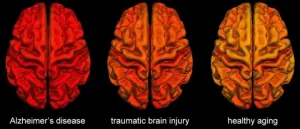
ELSE PRESS RELEASES FROM THIS DATE:
2021-04-26
Amsterdam, April 26, 2021 - Individuals with Parkinson's disease (PD) face a wide range of symptoms and challenges. A team from Parkinson's UK, including several Patient and Public Involvement (PPI) contributors, surveyed patients to find out which PD symptoms troubled them most and how priorities may change with condition duration. Their goal was to identify where improved treatments and strategies are most needed to help maintain independence and quality of life. They report their findings in the Journal of Parkinson's Disease.
"While PD has some common features such as tremor, rigidity, and bradykinesia, the disease is highly varied, with each individual experiencing their own unique blend of symptoms ...
2021-04-26
Violent continental collisions and volcanic eruptions are not things normally associated with comfortable conditions for life. However, a new study, involving University of Tennessee, Knoxville, Associate Professor of Microbiology Karen Lloyd, unveils a large microbial ecosystem living deep within the earth that is fueled by chemicals produced during these tectonic cataclysms.
When oceanic and continental plates collide, one plate is pushed down, or subducted, into the mantle and the other plate is pushed up and studded with volcanoes. This is the main process by which chemical elements are moved between Earth's surface and interior and eventually recycled back to ...
2021-04-26
A Lancaster University professor has introduced a new concept for rapidly analysing for the presence of a virus from colds to coronaviruses.
Based on analysing chemical elements the methodology, which has been adapted from an analytical technique used to identify metallic nanoparticles, is able to detect the presence of viruses within just 20 seconds.
Although the tests would need to be performed in a lab, it could be used to quickly identify whether people admitted to hospitals have been infected by a virus - enabling clinicians to decide treatments and also whether to admit patients into isolation wards.
The ...
2021-04-26
DETROIT (April 26, 2021) - A new study by Henry Ford Health System published in Arthroscopy: The Journal of Arthroscopic and Related Surgery may signal a first step toward eliminating the use of opioids to relieve pain after knee surgery.
A novel multimodal pain management protocol developed at Henry Ford can bring about immediate pain relief for knee injury patients without using powerful opioids like morphine, codeine, and oxycodone.
"Orthopedic surgeons can now perform meniscal knee surgery without the need for prescribing opioids whatsoever," said Toufic Jildeh, M.D., chief resident at Henry Ford's Department of Orthopaedic Surgery and the study's lead researcher. "We believe this non-opioid approach can be replicated for other types of orthopedic ...
2021-04-26
Philadelphia, April 26, 2021 - Fast turnaround of COVID-19 test results for healthcare workers is critical. Investigators have now developed a COVID-19 testing strategy that maximizes the proportion of negative results after a single round of testing, allowing prompt notification of results. The method also reduces the need for increasingly limited test reagents, as fewer additional tests are required. Their strategy is described in the Journal of Molecular Diagnostics, published by Elsevier.
There is an urgent need to reduce the spread of COVID-19 transmission in hospitals and care facilities and to maintain adequate levels of staffing. Group testing strategies with pooled samples have been proposed to increase capacity; however, the currently used strategies ...
2021-04-26
Buyer beware: single-family homes in floodplains - almost 4 million U.S. homes - are overvalued by nearly $44 billion collectively or $11,526 per house on average, according to a new Stanford University-led study. The study, published in Proceedings of the National Academies of Science, suggests that unaware buyers and inadequate disclosure laws drive up financial risks that could destabilize the real estate market. The threat is likely to grow as climate change drives more frequent extreme weather. (WATCH VIDEO: https://www.youtube.com/watch?v=n18s5kcE0So)
"The overvaluation we find is really concerning, ...
2021-04-26
Results of a study co-authored by MGH Institute of Health Professions researcher Teresa Kimberley, PhD, PT, have the potential to be one of the most impressive advances in decades to help improve the lives of patients who have had a stroke with resulting arm weakness.
In an article published April 22 in The Lancet, "Vagus Nerve Stimulation Paired with Rehabilitation for Upper Limb Motor Function After Ischaemic Stroke (VNS-REHAB): A Randomised, Blinded, Pivotal, Device Trial," the study reports that patients who incorporated vagus nerve stimulation during physical or occupational therapy showed 2 to 3 times the improvement in arm and hand function compared to those who received intense rehabilitation with sham stimulation.
"How ...
2021-04-26
With climate change looming, what must people hear to convince them to change their ways to stop harming the environment? A new Johns Hopkins University study finds stories to be significantly more motivating than scientific facts-- at least for some people.
After hearing a compelling pollution-related story in which a man died, the average person paid more for green products than after having heard scientific facts about water pollution. But the average person in the study was a Democrat. Republicans paid less after hearing the story rather than the simple facts.
The findings, published this week in the journal ...
2021-04-26
Humans have been breeding plants for their economic value for thousands of years. Traditionally, plant breeding techniques included cumbersome and time-consuming techniques like grafting and hybridization to enhance traits of economic value like disease resistance and high nutrition content. Now, with the ability to edit plant DNA using revolutionary gene-editing tools, particularly the CRISPR-Cas9 system, it is possible to enhance traits of economic value in plants easily and more efficiently than by using traditional techniques. But for that, it is necessary to sequence whole ...
2021-04-26
Osaka - Gallium nitride (GaN) is a semiconductor material whose wide band gap may one day lead to it superseding silicon in electronics applications. It is therefore important to have GaN characterization techniques that are able to support the development of GaN devices. Researchers at Osaka University have reported a nondestructive method for characterizing the crystalline quality of GaN. Their findings were published in Applied Physics Express.
GaN power switching devices offer numerous advantages including high-speed switching, high-power operation, low on-resistance, and high breakdown voltage. To take advantage of these properties, the defect density of GaN crystals must be low.
Threading dislocations ...
LAST 30 PRESS RELEASES:
[Press-News.org] Brain changes following traumatic brain injury share similarities with Alzheimer's disease
Using MRIs and machine learning, researchers mapped comparable degenerative changes in gray and white matter of the brain

